Introduction:
Flower pots are a popular addition to gardens, balconies, and indoor spaces, providing a natural and refreshing ambiance. Cement flower pots are durable and widely available, but choosing the right cement type can be challenging. In this article, we will guide you through choosing the right cement for your flower pots.
1. Portland Cement:
Portland cement is the most commonly used cement for making flower pots. It's durable, strong, and affordable. It is a hydraulic cement, which means it sets and hardens after mixing with water, making it an ideal choice for large flower pots that require strength to hold the soil. However, Portland cement is not suitable for small, delicate pots, as it may crack when exposed to rapid temperature changes.
2. White Cement:
White cement is a popular choice for making flower pots that require a smooth, polished finish. It is made from a mixture of white Portland cement and crushed limestone, making it suitable for indoor flower pots. However, it is relatively expensive and less durable than Portland cement, which makes it unsuitable for exposed outdoor areas.
3. Fiber-Reinforced Cement:
Fiber-reinforced cement is an excellent choice for making large flower pots that require significant strength. It is mixed with small polymer fibers that help to prevent cracks and make the pot durable. Fiber-reinforced cement is also resistant to water and moisture, making it ideal for outdoor flower pots.
4. Rapid-Setting Cement:
Rapid-setting cement is an excellent choice for making small flower pots that require a quick setting time. Rapid-setting cement sets and hardens quickly, typically within 30 minutes. It's ideal for making seasonal flower pots or small indoor pots. However, rapid-setting cement is less durable than Portland cement, making it unsuitable for larger flower pots.
5. Colored Cement:
Colored cement is a popular choice for making decorative flower pots with different colors and patterns. It is a blend of white Portland cement, pigments, and additives that give the cement its desired color. Colored cement is excellent for indoor flower pots but may fade when exposed to UV light, making it unsuitable for long-term outdoor use.
6. Masonry Cement:
Masonry cement is a blend of Portland cement, hydrated lime, and other additives, making it a suitable choice for making flower pots that require excellent workability. It has a slow setting time, allowing more extended periods of masonry work before it hardens. However, masonry cement is less durable than Portland cement, making it unsuitable for large flower pots.
7. High Alumina Cement:
High alumina cement is a hydraulic cement that is mixed with high levels of alumina to give it exceptional strength and durability. It is a suitable choice for making large outdoor flower pots that require significant strength to hold the soil and the plants. However, high alumina cement is expensive and relatively uncommon, making it difficult to find in some areas.
8. Lime Mortar:
Lime mortar is a blend of hydrated lime, sand, and water, making it an ideal choice for making small, delicate flower pots. Its flexibility makes it less prone to cracking when exposed to extreme temperatures, making it a suitable choice for indoor flower pots. However, lime mortar is less durable than other cement types, making it unsuitable for outdoor areas.
9. Redi-Mix Cement:
Redi-mix cement is a blend of Portland cement, sand, and water, making it an ideal choice for making small, seasonal flower pots. It is readily available and easy to use, making it a popular option for DIYers and beginners. However, redi-mix cement is less durable than other cement types, making it unsuitable for large flower pots that need to be strong and sturdy.
10. Slag Cement:
Slag cement is a hydraulic cement made from slag, a byproduct of steel production, and is mixed with water and Portland cement to make a durable and eco-friendly choice for making flower pots. It is suitable for indoor and outdoor flower pots and has a slow setting time, allowing excellent workability. However, slag cement can be challenging to find in some areas and may be more expensive than other cement types.

